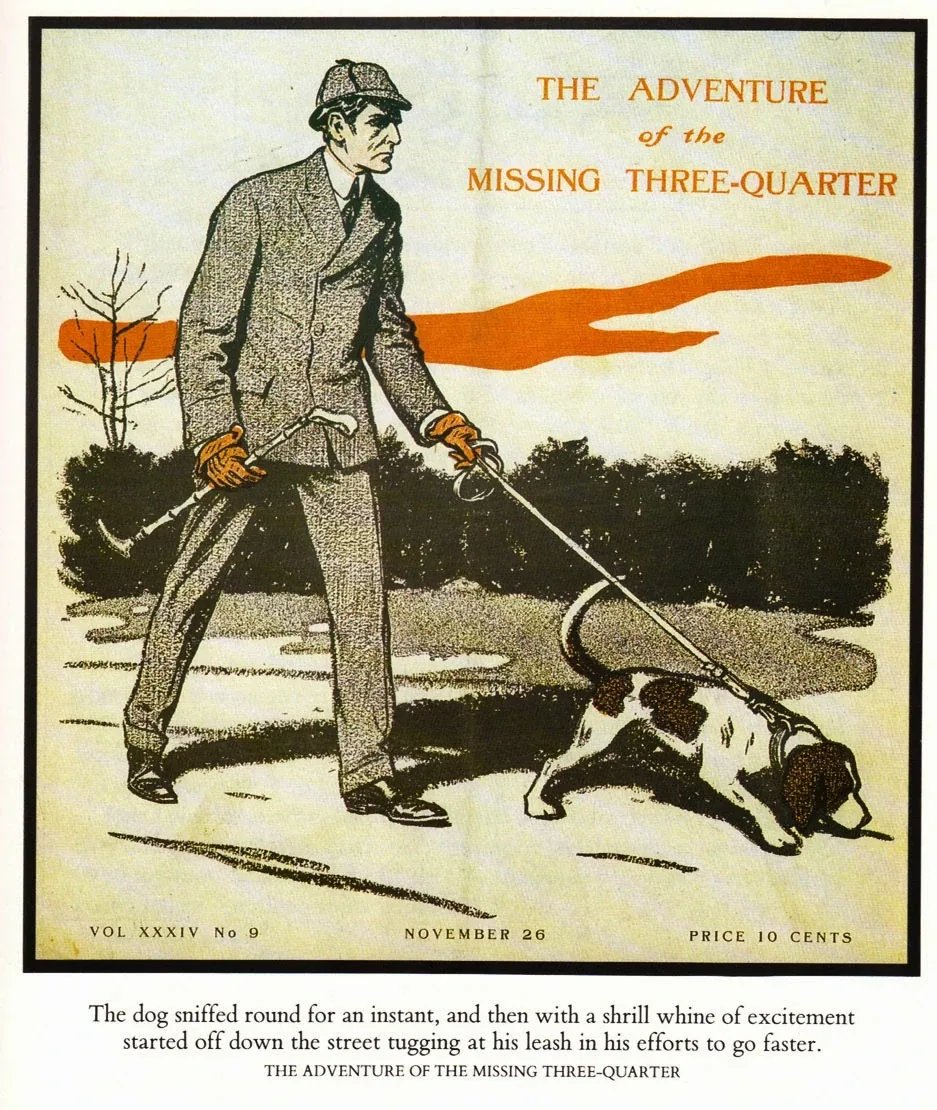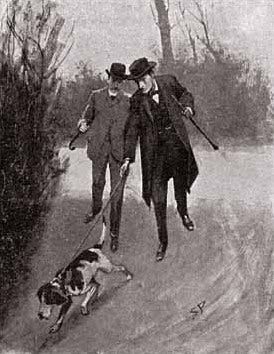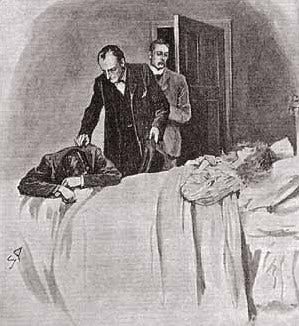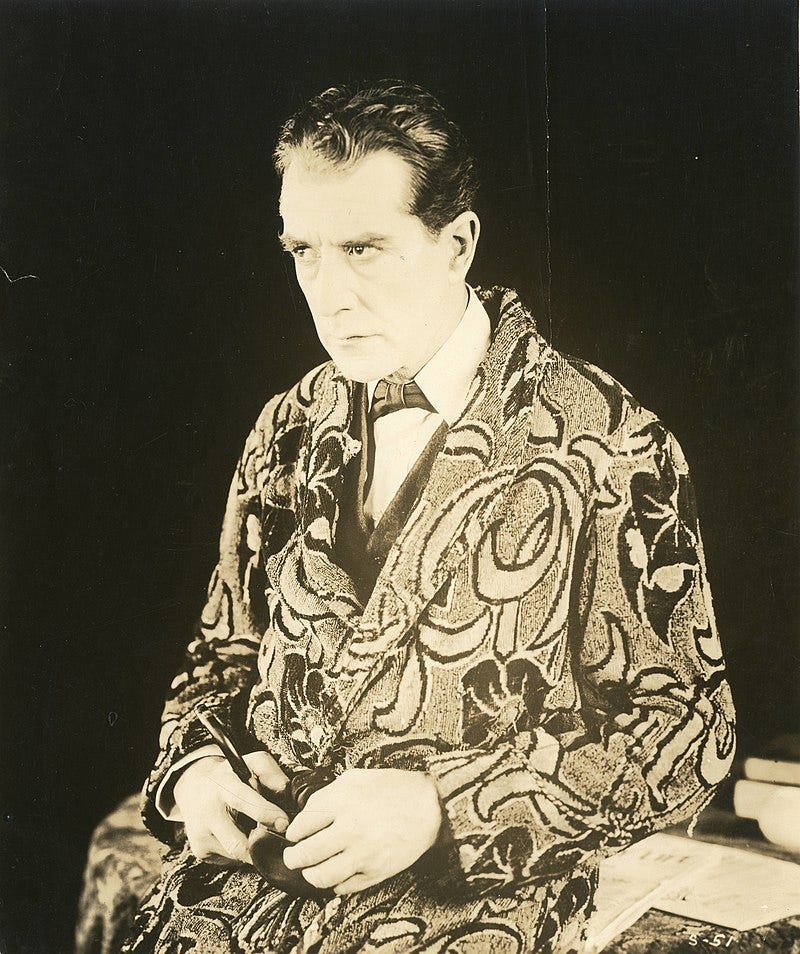The Adventure of the Missing Three-Quarter, by Arthur Conan Doyle, published 1904, later collected in The Return of Sherlock Holmes
 Sherlock Holmes and the dog Pompey. 1904 illustration by Frederic Dorr Steele.
Sherlock Holmes and the dog Pompey. 1904 illustration by Frederic Dorr Steele.
i'll be the first to admit i don't know shit about fuck about sports. i learned everything i know about American football from john madden memes. i heard that cricket matches could technically go on for days and i got scared. i know what a rugby uniform looks like because isn't it weird that the New Zealand national rugby union team called the "All-Blacks"?
anyway, The Adventure of the Missing Three-Quarter involves a a missing rugby player.
the summary
a rugby player named Godfrey Staunton on the Cambridge team has gone missing. he plays the "three-quarter" position, hence the name of the story. it's only days before their major match with Oxford and they're unlikely to win without him. the owner of the team, Cyril Overton, comes to Sherlock Holmes asking for his help in the matter.
Overton says that the previous night, Staunton was seen receiving a message from a rough looking bearded man at the hotel he was staying. according to the witness, the news was devastating and the two of them left the hotel together quickly. Staunton hasn't been seen since.
Holmes and Watson go to the hotel and question the witness, a hotel porter. the porter says that before he disappeared Staunton wanted to send a telegram but once the message was drafted said he wanted to deliver it himself. when searching Staunton's desk, Holmes discovers a blotter, something used to soak up the excess ink of the mail Staunton intended to send. the part of it that is legible reads "Stand by us for God's sake" indicating that there's more than one party involved with Staunton's disappearance. Holmes also finds a couple of bills and other papers.
Staunton's uncle and closet living relative, Lord Mount-James, arrives. he was telegraphed by Overton to see if he knew anything about his whereabouts. Lord Mount-James is apparently incredibly wealthy but a miser and refused to give any of his money to Staunton before he himself passed away. he provides no other information and even threatens Holmes to stop looking into the matter if he expects to get paid for his actions. Holmes points out that Staunton might've been kidnapped in order to extort Lord Mount-James for his money and at that, Lord Mount-James tells him to locate Staunton as soon as possible.
Holmes goes to the telegram office and tricks the worker into showing him the counterfoil of the telegram Staunton sent the day before. this basically a document that shows the message and intended address of the telegram. it was addressed to Dr. Leslie Armstrong, a doctor at Cambridge. this name becomes familiar to Holmes as he picked up a bill of services from Dr. Armstrong on Staunton's desk.
Holmes and Watson go to visit Dr. Armstrong who doesn't know anything about Staunton. when confronted about the bill, Armstrong gets angry and kicks them out of his home, refusing to answer any more questions. Holmes and Watson stay in an inn across the street from Dr. Armstrong's office to keep an eye on him as he's clearly the most suspicious.
the doctor has been seen taking a carriage out to the country regularly but no one has seen has destination. Holmes tries to follow Dr. Armstrong on bicycle, but the doctor catches on and gives him the slip. in secret once the doctor has returned from his trip, Holmes coats the wheels of the carriage in aniseed oil. the next day when he goes to make the trip, Holmes uses a beagle-foxhound named Pompey from the village to track the scent of the aniseed oil.
 Holmes and Watson follow Pompey the dog. 1904 illustration by Sidney Paget.
Holmes and Watson follow Pompey the dog. 1904 illustration by Sidney Paget.
Holmes and Watson follow the trail and witness Dr. Armstrong's carriage apparently returning and stay out of sight. they continue on the path and come across a solitary cottage. when they are about to enter, they see the carriage returning and go inside.
inside, they find Staunton sobbing over the corpse of a recently deceased woman. Dr. Armstrong and the bearded man from the porter's story enter the house. Armstrong is about to fly into a rage, but Holmes asks him to remain calm and says that they probably thought each other adversaries in the whereabouts of Staunton this whole time. Where Holmes and Watson thought Armstrong responsible for Staunton's disappearance, Armstrong thought them hired by Lord Mount-James to reveal the sensitive information they stumbled upon in this cottage.
 Holmes and Watson find Godfrey Staunton by the bed of his dead wife. 1904 illustration by Sidney Paget.
Holmes and Watson find Godfrey Staunton by the bed of his dead wife. 1904 illustration by Sidney Paget.
Staunton was the husband of the woman who recently died, the bearded man her father. Staunton married the woman in secret last year, thinking that Lord Mount-James would disown him if he found out as he most certainly would've disapproved of the marriage. unfortunately, the woman came down with tuberculosis and her condition was getting worse and worse. Dr. Armstrong was an old friend of Staunton and vowed to take care of his wife and keep the secret while he treated her. Staunton ran away in the night upon receiving the news from her father that her condition was getting worse and she would not survive the week. Staunton has been at her bedside since.
Holmes vows to the doctor that he and Watson will keep this information secret and leave the cottage behind them.
the analysis
it's a sad one ain't it. but it is one i really like! the way that the mystery opens poses so many people as the possible culprit, could it be an enemy from Oxford? Overton himself? the bearded stranger? maybe even Lord Mount-James? and then through careful deduction, the mystery narrows to a single suspect and or at least someone that's most definitely involved. this mystery unfolds with its emotional beats which i think is fun and a little atypical for a canonical story. the passions and emotions of people become the cornerstones for the clues as they are discovered.
Watson takes a bit of a backseat, the story is a bit more concerned with the exploits of Holmes as he tromps around and makes his deductions. Holmes is also quite cocky, the way he turns Lord Mount-James argument about money matters back on him was a fun reversal. i enjoyed Holmes complaining to Watson about following Dr. Armstrong's carriage on bicycle and then Watson suggesting he try his hand at following the doctor in the same way, to which Holmes tells him it'd be fruitless for him to try. Dr. Armstrong's misunderstanding about Holmes and Watson's intentions making the mystery more difficult to solve is an enjoyable aspect just for the fact of having an adversary to face up against and figure out how to outsmart.
the story obviously ends on a sad note, concluding the emotional arcs of the story in an unexpected way. it's surprising and melancholy though, not shocking. or at least not shocking in the hinging your entire plot on sexual abuse kind of way. tuberculosis is a serious illness and despite what the western world will tell you, it's still a disease that exists today. while modern medicine has helped and can cure people of it before the infection becomes full blown TB, it still affects many people in the United States and around the world. it was a much less treatable illness in the early 20th century though. it was known as the "wasting" disease and if you've ever heard of someone "dying of consumption" it's TB. "consumption" was used as the term because people liked it to your body "being consumed".
it's another mystery where there is no crime technically being committed, just a man in a difficult place and a tragedy striking at an inopportune time. it is among one of the more depressing stories, but one that i think resolves with the proper closure it deserves. i think that it's a lot more interesting when mysteries don't have to end with someone in handcuffs. there's a poetry to this story that i appreciate despite the content.
ok but what do other people think?
people don't like this story that much. well, they trend toward the negative moreso than they do the positive. the story has a 3.48 on Goodreads. for something to compare it to, one of the most beloved short stories, A Scandal in Bohemia, has a 4.23 on Goodreads. the consensus seems to be that this story is just "alright". nothing too special and forgettable.
from Goodreads user Meg:
[...] A lot of running around without much result for a while and the reader had no chance to figure out why. Makes for a dull story.
from Goodreads user Liz:
A lackluster story of a missing rugby player with a scrooge for an uncle.
and from Goodreads user Crime Addict Sifat:
[...] I will not recommend this story to anyone.
Among the people that like this story, they point out liking the character of Dr. Armstrong and compare him to Moriarty. i don't know if that comparison is apt, Dr. Armstrong is just a doctor and not a secret crime empire owning professor, but i also appreciated the appeal of having some kind of an "enemy" for Holmes to go up against.
the ending also seems to be divisive, with people liking the twist at the ending and find it appropriate if not sad or people being disappointed in the build up. i can see why it'd be disappointing if you put too much weight on Dr. Armstrong trying to fill Moriarty's shoes.
adaptions and conclusion
again, an unfavorable story to adapt. i think people would rather adapt something with... a crime yknow? and with dealing with tuberculosis, it'd be a bit of a heavier story to deal with for the unprepared. it's one that's mostly been adapted in the form of audio dramas or for the radio.
there's a series of short films produced by a silent film company Stoll Pictures that seems to be the only one that has adapted this story as is. 45 of the 56 short stories were adapted into short films and 2 of the 4 novels were adapted into full length films. The Adventure of the Missing Three-Quarter is among one of the stories they adapted.
in the Stoll films, Sherlock Holmes is portrayed by Ellie Norwood. ACD was still alive to see all of the Stoll films and apparently was amazed by and admired Norwood's impersonation of Holmes:
He has that rare quality, which can only be described as glamour, which compels you to watch an actor eagerly even when he is doing nothing. He has the brooding eye which excites expectation and he has also a quite unrivaled power of disguise. My only criticism of the films is that they introduce telephones, motorcars and other luxuries of which the Victorian Holmes never dreamed.
Starrett, Vincent (1993). The Private Life of Sherlock Holmes. Otto Penzler Books. p. 156. ISBN 1-883402-05-0.
 Norwood as Sherlock Holmes in 1923 By Unknown author - J. Willis Sayre Collection of Theatrical Photographs, Public Domain, https://commons.wikimedia.org/w/index.php?curid=80629564
Norwood as Sherlock Holmes in 1923 By Unknown author - J. Willis Sayre Collection of Theatrical Photographs, Public Domain, https://commons.wikimedia.org/w/index.php?curid=80629564
with such a glowing review from the author himself, i'm very curious about the Stoll films and i'll definitely be adding them to my list of things to watch. Norwood is among one of the actors to portray Holmes that i think has the "silhouette" as defined by the illustrations by Sidney Paget in the original publications of the story. i'd be very curious to see how his performance compares to Rathbone's and Brett's who i'm much more familiar with and fit that same "silhouette".